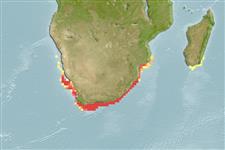Common names from other countries
Teleostei (teleosts) >
Centrarchiformes (Basses) >
Latridae (Trumpeters)
Etymology: Chirodactylus: Greek, cheir = hand + Greek, daktylos = finger (Ref. 45335); for the long, unbranched lower pectoral fin rays (Ref. 120445).
More on author: Cuvier.
Environment: milieu / climate zone / depth range / distribution range
Ecology
Marine; reef-associated; depth range 0 - 240 m (Ref. 9492). Subtropical; 23°S - 36°S
Southeast Atlantic and Western Indian Ocean: Walvis Bay, Namibia around the Cape to Delagoa Bay, Mozambique.
Size / Weight / Age
Maturity: Lm ? range ? - ? cm
Max length : 40.0 cm TL male/unsexed; (Ref. 9492); common length : 25.0 cm TL male/unsexed; (Ref. 9492)
Found in coastal waters from the shoreline to about 240 m depth, associated with reef areas (Ref. 9492) and rocky bottoms (Ref. 5319). Feeds on invertebrates (Ref. 27121).
Life cycle and mating behavior
Maturity | Reproduction | Spawning | Eggs | Fecundity | Larvae
Smith, M.M., 1986. Cheilodactylidae. p. 667-668. In M.M. Smith and P.C. Heemstra (eds.) Smiths' sea fishes. Springer-Verlag, Berlin. (Ref. 5319)
IUCN Red List Status (Ref. 130435)
CITES (Ref. 128078)
Not Evaluated
Threat to humans
Harmless
Human uses
Fisheries: minor commercial; gamefish: yes
More information
ReferencesAquacultureAquaculture profileStrainsGeneticsElectrophoresesHeritabilityDiseasesProcessingMass conversion
Tools
Special reports
Download XML
Internet sources
Estimates based on models
Preferred temperature (Ref.
115969): 12.2 - 24.5, mean 16.4 (based on 44 cells).
Phylogenetic diversity index (Ref.
82804): PD
50 = 0.6250 [Uniqueness, from 0.5 = low to 2.0 = high].
Bayesian length-weight: a=0.01175 (0.00560 - 0.02463), b=3.04 (2.86 - 3.22), in cm Total Length, based on LWR estimates for this (Sub)family-body shape (Ref.
93245).
Trophic level (Ref.
69278): 3.5 ±0.37 se; based on food items.
Resilience (Ref.
120179): Medium, minimum population doubling time 1.4 - 4.4 years (Preliminary K or Fecundity.).
Fishing Vulnerability (Ref.
59153): Low to moderate vulnerability (30 of 100).
